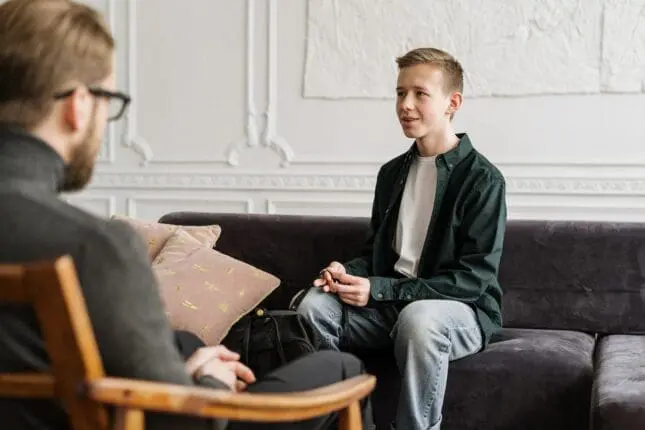Q: My teen clients will chat with me during sessions, but as soon as I say something that sounds remotely like an intervention, the conversation dies off. What can I do to keep a lively interaction going while still being able to address the issues that come up?
A: For many teenagers, few things are less appealing than the prospect of talking with adults. Can you blame them? Too often, adults quickly refashion conversations into know-it-all lectures, boring monologues, or annoying reprimands. Absent are the reciprocity and mutual curiosity you normally see when two people engage authentically. Instead, many exchanges between parents and teens serve largely as attempts to restructure the young person’s beliefs and behavior in alignment with parental ideals.Most of the teenagers I’ve worked with tell me they’d actually welcome talking with their parents, as long as they had the kind of conversations in which people talk about the things that matter to them without the other party jumping in to fix things or pontificate about what should matter. The same principle applies to conversations between therapists and their teen clients. I’ve found that if we pay attention to what derails our interactions with young people, we can learn a lot about how to facilitate more engaging ones. Sometimes, in fact, all you have to do to keep a conversation alive is avoid doing the things that tend to stop them.
So here are some approaches to building conversation that allow me to connect with my young clients without making them feel self-conscious, pounced upon, called out—and without requiring them to be more committed to therapy than they are at that particular time.
Don’t Rush In
There’s a vital “middle space” in the sequence of intervening with teenagers that therapists often hurry through or neglect altogether. It’s that space where a young person’s problems finally come to light without the need to shift immediately into problem-solving mode. Typically, therapists use the term safety to refer to a client’s sense of comfort regarding distinctive features of the therapy relationship, such as confidentiality, unconditional regard, and the absence of criticism or judgment. All of these are important, but I think safety also has to do with a client’s freedom from worrying about having a conversation hijacked by a therapist’s need to be helpful, make a point, or send the client home with “things to try.”
When adolescent clients open up in therapy, especially after not having said much at all, some clinicians respond too eagerly. Perhaps worrying that they won’t have another opportunity to address a particular issue, they move right in to offer suggestions like write in your journal, try deep breathing, think about a positive memory, envision a safe place. This may make the therapists feel good about their efforts, but it’s not necessarily what the teens want or need, which is a place where they can think out loud and trust that their ideas and opinions won’t be immediately dismantled in favor of a more “logical” line of thinking. Besides, there’s nothing about those suggestions that lets clients know that they’re really being seen and heard.
It’s easy to understand, of course, why most therapists may hustle in with a plan, a contract, or an assignment when young clients finally open up to talk about potentially alarming issues. For instance, 16-year-old Erin, sitting with her therapist one afternoon, decided to bring up her cutting behavior. Earlier she’d told her therapist, Marcy, that she’d cut herself whenever she was worried that her friends were mad at her. But Erin had never wanted to talk further about it and had always resisted Marcy’s efforts to reopen that conversation. On this day, however, Erin said that she didn’t like it when she self-harmed, and that sometimes it scared her. “But it helps me,” she added.
Relieved to finally be hearing this from Erin, rather than her parents, and eager to bring the cutting under better control, Marcy said, “It might help more if you can think of three things to do instead of cutting when you feel like hurting yourself. We can keep adding to the list each week. Maybe,” she continued, “we can put it in a little notebook, a pocket-sized one that you can always keep with you. I can teach you a lot of different alternative things to try.”
Erin’s face closed immediately. “Jeez, just because I said it scares me sometimes doesn’t mean you have to freak out about it,” she said stiffly. “I kinda just wanted to tell you about it, but forget it.”
A better first step would’ve been for Marcy to address Erin’s ambivalence about self-harming—the impulse to cut and the wish to not cut, the embarrassment caused by scars and thinking that scars are cool, hoping someone notices the self-harm and wanting to keep it hidden. Inviting Erin to unpack her feelings about cutting and its emotional benefits would’ve demonstrated Marcy’s respect for Erin’s timeline and “proprietary rights” to the problem. Erin’s cutting compulsion, unless it resulted in a devastating injury, was hers to manage or resolve, not her therapist’s. The bottom line: when our young clients trust us to hold the space without rushing to solutions, they’re likelier to relax their vigilance and ease into more therapeutically productive conversations.
Let It Be, But Keep It Real
I once saw an angry 14-year-old girl, Paige, in family therapy who, for her first three sessions, swore up and down that she had no problems. In the fourth session, following her dismissal of her father’s comment about how Paige’s argumentativeness and surliness were taking over the family, I said, “Paige, I know it’s difficult for you to acknowledge the impact of your distress on the other members of your family . . .”
Cutting me off, she blurted, “Why should I worry about them? I’m the one with the problems!”
I could’ve chosen to point out the contradiction in her statements, but to what end? It would only have shown Paige that I was more interested in making a point than in trying to understand her. Plus, kids feel betrayed when a remark they made in one context is cross-referenced in another by an adult who seems only to want to trap them into adopting some kind of viewpoint. It simply boils down to a matter of trust—trust that I won’t exploit the words that might fly from her mouth, trust that I have her best interest in mind, and will help her save face in front of her family whenever possible.
So what did I end up saying to Paige after she blurted out her lack of concern about her impact on her family? I told her gently, “Paige, no matter how bad or how painful your problems are, you’re still part of something bigger—your family, your circle of friends, and your community. If you lose sight of that, I worry the world could become a lonely place for you.” I wanted to help her understand that her way of managing her problems and moods would ultimately leave her feeling isolated, and that even her sense of righteousness wouldn’t protect her from that, but I purposely framed my comment as something Paige wouldn’t feel she had to actually respond to. Rather than risk it coming off as an “intervention,” I wanted to leave it out there, an intriguing observation that she could digest over time and I could return to in subsequent meetings if I chose.
As it happened, at the end of this session Paige asked if she could begin meeting with me individually—this from a kid who, when first brought in by her parents, was determined to have nothing to do with therapy. I can’t say for sure, but I suspect that my unwillingness to placate Paige in order to keep a false peace, plus my willingness to express what everyone was probably thinking but too afraid to say out loud, drew her toward a connection with me. This is the authenticity that so many teenagers seek from their relationships with adults. They want relationships to be transparent, nonconfrontational, and emotionally responsive. In this instance, it was absent any directive that Paige must change something about how or what she was doing. That I thought she should consider my view was obvious, but I believe my respect for her autonomy and decisions regarding doing things differently made it a little easier for her to do so.
Holding the Space
Generally, kids who are brought into treatment already have enough people telling them what to do differently. What they may not have are relationships with caring adults in which they can reveal the things they really think about, and experience how those things sound and feel when spoken out loud. In a conversational space that’s prescription-free—when we’re not telling teen clients to stop it, change it, apologize for it, or analyze it—they begin to take ownership of the choices they’re making. This heightened accountability allows them to then consider change and take responsibility for it.
This approach to working toward change with adolescents is different from what most of us would use with adults, since it doesn’t rely on discussing and agreeing upon specific therapeutic goals. A therapist and a teen client will be aware, of course, that the purpose of meeting is to alleviate the teen’s depression, or help her adjust to her parents’ divorce, or figure out why he’s no longer interested in doing well at school. But making the conversation about these goals isn’t going to elicit the kind of animated dialogue that engages kids and brings their full selves into the room without making them self-conscious.
Still, progress is made with my teen clients because we’re always moving in the direction of emotional health. Better emotional health and emotional intelligence mean better discernment, empathizing, perspective-taking, boundary-setting, and articulating of one’s needs, even if we’re not talking specifically about any of these things. The fact that most of our teen clients never asked for our help in the first place is another reason why a focus on treatment objectives has a more limited application with teenagers than with adult clients. Talking about goals for therapy with kids who have no interest in the process ignores their message of “I don’t want this.” Therapists end up looking as if they’re steamrolling over their clients’ reticence in order to get on with the show. It’s a huge disconnect.
I’ve always felt that one of our bigger challenges in adolescent therapy is getting the client to forget that he didn’t want to come, or that she didn’t want to talk. We can do this by offering interpersonal experiences that are so inviting teens join in of their own accord. That’s how we get out of the conundrum of “How do I get this kid to talk with me?” Once we become compelling enough that our clients actually want to talk with us, everything about being with and helping these teenagers starts to feel a whole lot better and more promising.
Photo by cottonbro/Pexels
Janet Sasson Edgette
Janet Sasson Edgette, PsyD, is the author of Therapeutic Conversations with Adolescents: Helping Teens in Therapy Thrive in an Ultra-Competitive, Screen-Saturated World, Adolescent Therapy That Really Works: Helping Kids Who Never Asked for Help, Stop Negotiating with Your Teen, and The Last Boys Picked: Helping Boys Who Don‘t Play Sports Survive Bullies and Boyhood. She practices in the Philadelphia suburbs. Contact: info@janetedgette.com.












